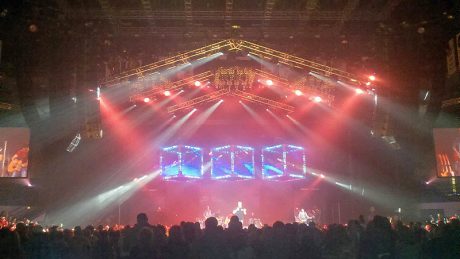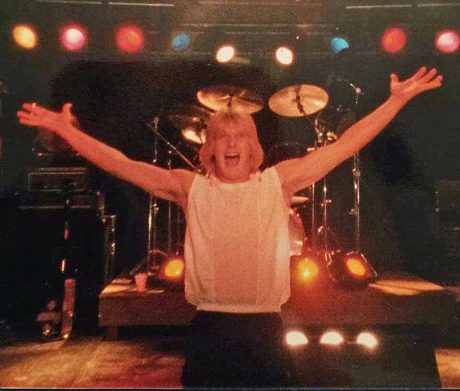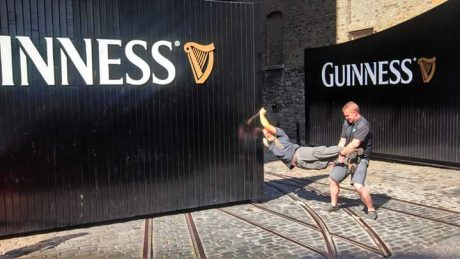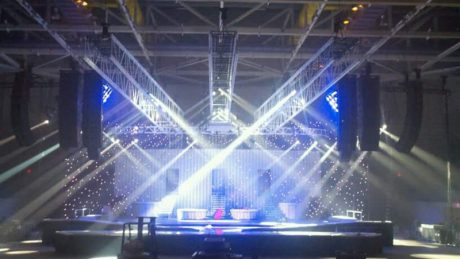
The first thing Andy Knighton wants you to know about him is that he works on all his vehicles. “I grew up in a small town where you’d fix your own cars, repurpose them, or soup them up, and then hang out in the grocery store parking lot with the hood up because you think you’re cool,” he laughs. But it’s telling because as a lighting director for some of the greatest designers in our business, he inevitably has to get under that hood.
Knighton recently took home a Parnelli Award for his lighting director work with Rascal Flatts, a band he’s been with since 2003. He sees a big part of his success as being able to stay tight with the band. “You build up a rapport with them to the point where you know they are going to burp before they know they are going to burp,” he says. That’s pretty specific, and assuming there’s an “excuse me” somewhere in this analogy, it gives further insight into his success. “The lighting director has to keep the vision going. You’ve got to be part of the band. Lighting is an instrument — you’re just not onstage.”

Punk Kid
Knighton grew up in the storybook town of Hendersonville, 20 miles north of Nashville. By his own admission, he was a “punk kid” drawn to the music scene. “I remember my first concert, it was Alice Cooper,” he says. Other concerts ensued, and he became mesmerized by all the trappings of the Big Rock Tour. “I was thinking I wanted to be involved with something like that, but I had no idea how to do it.”
Meanwhile, working in a bar, he started helping bands with some pretty primitive lighting elements, and when a regional group out of Kentucky called The Risk asked him to come out on the road with him, he said yes. It was a far from a glorious foray, as it mostly involved living with two other guys in a camper-type trailer, getting by on food stamps. But he and a friend started buying equipment together, and local bands that didn’t have PA and/or lights started hiring them.
Being a Tennessean, when new lighting gear was needed, Knighton naturally became a customer of Bandit Lites. “Then, one day in 1998, they asked me if I wanted to go out on a Brooks & Dunn tour, and I said yes,” Knighton says, still sounding surprised by it all.
It was a whole other world indeed. “As confident as I was in the bar world, the arena world was a completely different animal.” He more than held his own, because soon he was running lights for country singer Jo Dee Messina. (He continues to return to B&D and was the lighting designer and director for their 2018 New Year’s Eve show.) When Messina got big enough to go out on her own, she rang up Knighton, who had that point had collected a catalog of designs and concepts. She liked them and him, so off they went.
In 2001, a new group called Rascal Flatts came along and opened for Messina. In 2003, Rascal was ready to go out on their own, and they asked Knighton to come along.
“At that point, they were very young and had a limited support package,” he says. “But in 2004, they brought in Larry Boster, who was then the lighting designer for Brooks & Dunn, and he designed their first headlining show and handed me the keys. He trusted me to keep the system correct, and I just programmed it and off we went.”
The band would quickly establish itself as a premiere act, and every tour since had our industry’s best lighting designers coming to their table. It is an impressive list of winners: Larry Boster, Bruce Rodgers, Mike Swinford, Seth Jackson, Bob Peterson and, most recently, Sooner Routhier.

Snap Decisions
Knighton is a Bandit associate, and when he’s not out with Rascal, he’s doing every and anything else. “I do crew chief work,” he says. “I’ll help out with sound, video, anything that is needed on any other show or special event Bandit is asked to do.” He’s been a part of everything including NFL Drafts and NASCAR events; corporate clients like Jack Daniels; and other music acts as diverse as Journey and the Boston Pops. But the hat he’s most known for wearing is that of the director. And like everything in this business, that role is not cookie-cutter, but can vary wildly depending on the act.
“With a really big pop act, where you’re in that similar big arena every night, the design of the show can’t fluctuate, so that lighting director’s job is to make sure everything stays on track,” he explains. “A Vegas residency is another example of that situation. But when you’re with a band like Rascal, it’s different every night in every venue in some way.” He points out that, as they certainly can sell out arenas, they prefer to get closer to the audience, which means playing a wider variety of venues that allow for that. This inevitably means the rig needs to be altered in ways big and small. The lighting designer’s exact vision is always the goal, but variables can intervene. That causes the director to make changes on the fly. “When the rig alters, the programming alters, and there’s a ripple effect. It makes you think of things that the designer hadn’t had to think about it, and I just flip open my tool box and ‘adjust the transmission.’ But I love it, because working with different obstacles every day keeps your chops honed.”
For Knighton, it’s about being prepared and being able to make snap decisions — having dexterity and sound judgment when in the trenches. “You have to be able to adapt,” he says. “Bob Peterson uses the phrase, ‘Real World Lighting,’ for his company, and it’s the greatest, most accurate name for what this business is actually about,” Knighton adds. “Some designers throw out great ideas that are just not applicable to the real world. I will always give them a black-and-white answer.”

Naturally, he has some stories of working with some of these great designers. “Seth [Jackson] was one of early my ‘oh sh*t!’ moments,” he laughs. On a Women of Faith tour, Jackson designed the set and the lights, and Knighton figured Jackson was going to program it and then they would go out on the road together. But Jackson just gave Knighton the keys and a “see ya later” salutation, leaving Knighton with the realization that he has to program it and take care of any issues on the road. “He told me it was all me at that point, and I thought, ‘Man, if I don’t pull this off, I’ll never work again!’”
He does admit that sometimes he wonders why at this point he’s not called on more often for more design work, but “then you back up a notch and realize that these are opportunities to see how other people think and get a broader vision. Then the next time you get to design a show, you have more tools in your tool box because of the experience with that next great designer.” Also at this point, Knighton is usually brought in early on the creative process, and everyone is open to his suggestions because, even when everything about a show is “approved,” no one knows how it’s actually going to work on the road quite like Knighton. Speaking of tools, he says he started out on the Whole Hog II. “That was the premiere console, and then we started adding [features/outboard gear] to it to the point where it got overloaded and was suddenly moving like molasses on a January day. This forced us over to the grandMA, which just killed. The parameters got bigger, and bigger still with the grandMA2.”
Otherwise, as a guy who does this for a living, he is appropriately skeptical of constant barrage of “latest and greatest.”
“Bandit’s warehouse is filled with 470 flavors of LED lights,” he says, apparently only slightly exaggerating. “So, do we really need more? Often when a designer wants [a specific product], something suitably similar can be found that does the job just fine. Nobody in the crowd that paid $52.50 for a ticket can tell you if the light on their music star is x or y [brand]. Nothing matters if you can’t make it fun, make it a big party.”
He does make it fun, and does make it a big party, as his moment on stage at the 2018 Parnelli Awards stage confirmed. “Hearing your name listed among all these other great directors was so rewarding,” he says. “Then you hear your name [as the winner] and it’s like ‘holy sh*t are you serious?’ You don’t even know how to accept it. What a thrill it was to go back to the hotel later and go, ‘Sumbitch, you did it.’”


